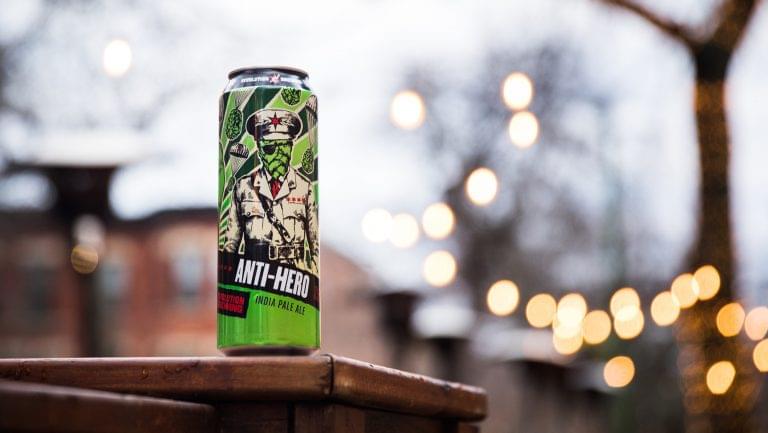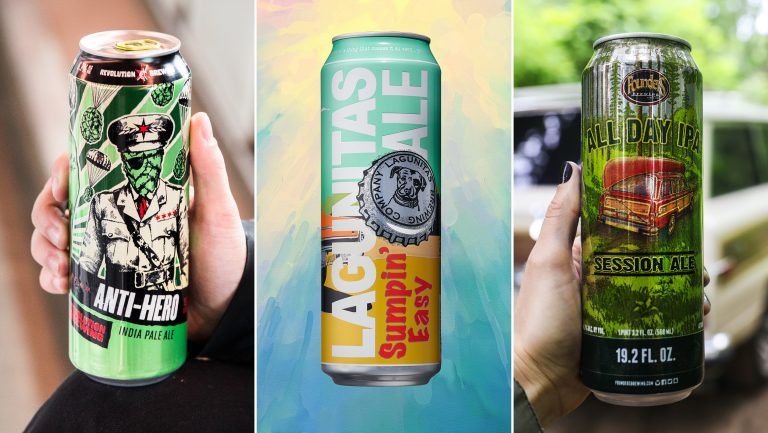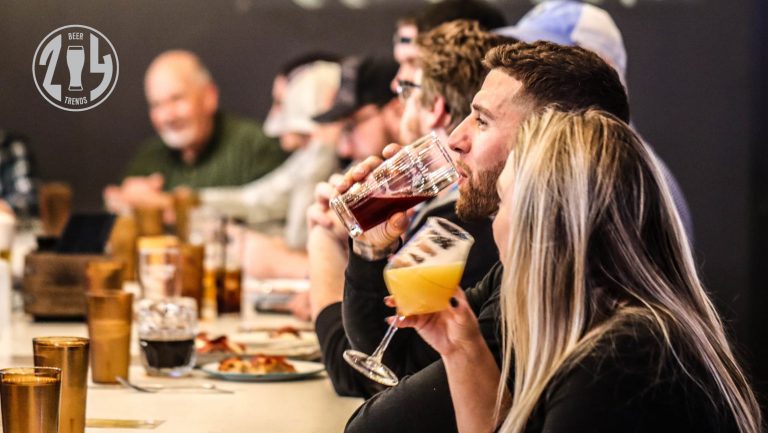Size matters when selling packaged beer in places like Chicago, where a local ordinance forbids the sale of single containers totaling 16 ounces or less. The packaging, says Doug Veliky, the CFO and head of communication at the city’s Revolution Brewing, “needs to be 16.1 ounces or [more].”
In 2017, as Revolution began exploring new retail outlets—specifically, convenience stores and gas stations—it decided to package its flagship Anti-Hero IPA in 19.2-ounce cans, sold one at a time. Introduced that fall, the gently priced (around $3) larger format toed the legal line and tapped a lucrative new vein of grab-and-go consumers. “It’s been huge for Anti-Hero,” says Veliky, noting that the 19.2-ounce format currently accounts for more than 4 percent of Revolution’s total production. “[Sales of] Anti-Hero probably would’ve been flat last year without the 19.2-ounce can. It really helped us keep that brand growing and getting into new hands.”
Large cans of domestic lagers and flavored malt beverages from big beer brands have long been stocked in fridges at gas stations and convenience stores, offering consumers a low-cost, no-fuss cold tallboy to go. Now many craft breweries are going big, packaging robustly flavored IPAs and hop-forward ales in 19.2-, 24-, and 25-ounce cans. They’re typically sold for $2 or $3, encouraging consumer trials and boosting sales.

Don’t miss the latest drinks industry news and insights. Sign up for our award-winning newsletters and get insider intel, resources, and trends delivered to your inbox every week.
Sales of these larger formats represent a small yet rapidly increasing segment of the overall craft beer market. Over the 52 weeks that ended June 15, Nielsen reports that 19.2-ounce can sales grew nearly 200 percent at off-premise outlets and now account for nearly 1 percent of all craft dollars. (The 24- and 25-ounce cans were up 145 percent during the same period and account for half of 1 percent of craft dollars.)
The oversized cans are “able to find space in channels where a six-pack or larger [package] doesn’t necessarily make sense, from a format perspective,” says Caitlyn Battaglia, a client manager for Nielsen’s Beverage Alcohol Practice Area, who is based in Roanoke, Virginia. “You’re also hitting on different occasions.”

The Convenience Factor
If you buy beer at a grocery, liquor, or specialty store, chances are you’re stocking up, maybe choosing a six-pack or 12-pack—a selection to stash away. Few folks earmark 19.2-ounce cans for a rainy day. “When consumers go to a cold box or refrigerated space to grab [a single-serving beverage],” says Battaglia, “it’s more often than not for immediate consumption.”
This immediacy opens new occasions to craft beer, such as sporting events and concerts, and even commuter train rides, where one big beer makes sense, by maximizing liquid and minimizing the need to re-up. There’s a convenience factor associated with getting a bit more beer in a single serving.
“My buddy is a big golfer,” says Max Wertheimer, the senior public relations manager at Lagunitas Brewing, headquartered in Petaluma, California, “and he grabs a [19.2-ounce can of Lagunitas] 12th of Never at the clubhouse before he tees off and keeps that in his cart. It’s about meeting consumers where they are.”
In addition to 12th of Never, a citrusy pale ale, Lagunitas offers its flagship IPA and the smooth and wheat-y Sumpin’ Easy in 19.2-ounce cans (all are priced around $2). The three beers offer customers a range of flavors and styles, something to appeal to different drinkers and entice them to take a couple-buck flier. “Consumers have an opportunity to try our beers without investing in a six-pack,” Wertheimer says. Selling a single can opens the door to buying more beer later on. “If you haven’t had our IPA and you buy a 19.2-ounce can at a festival or a ball game,” says Wertheimer, “we would hope—and expect—that there will be a 12-pack of our IPA in your fridge shortly after.”

Finding Gaps to Fill
If consumers only bought beer at taprooms, the oversize-can trend might seem like fake news. At breweries, four-packs of 16-ounce cans reign supreme—one size to rule them all. “There’s a misunderstanding of what success looks like for these cans,” says Revolution’s Veliky. In New York City, for example, almost half of Revolution’s off-premise sales are 19.2-ounce Anti-Hero cans, with prominent outlets including Walgreens and Duane Reade drugstores. “Taprooms are not the place for them to be sold,” Veliky says. “People aren’t going to small taprooms for convenience. They’re going there on an excursion. These breweries probably shouldn’t even want to sell this format.”
Veliky, who writes the data-driven Beer Crunchers blog, notes that a limited number of large-can suppliers produce printed 19.2-ounce cans, and minimum orders start at 25 pallets—more than 125,000 cans. The cans require tons of storage space and liquid, boxes best checked by America’s largest and most widely distributed craft breweries.
It makes sense, then, that larger craft brewers like Dogfish Head in Milton, Delaware, is selling its 19.2-ounce cans of 60 Minute IPA and SeaQuench Ale (around $3 each) in convenience and grocery stores, and that Oskar Blues, which runs production breweries in Longmont, Colorado, and Brevard, North Carolina, puts several year-round beers in the 19.2-ounce format it calls stovepipes, including Dale’s Pale Ale, Pinner Session IPA, and Mama’s Little Yella Pils (around $3 each). America’s top-selling 19.2-ounce can, though, is Founders Brewing’s All Day IPA, which retails for a value-oriented $1.99.
“We knew the price would create consumer pull,” says Mike Stevens, the CEO and a cofounder of the Michigan company, which has breweries in Grand Rapids and Detroit. Year to date, sales of 19.2-ounce All Day IPA cans have risen nearly 34 percent, according to IRI data, and the format has seen success in convenience stores and stadium venues. Says Stevens, “This is a great feed into those channels.”
Instead of dumping Founders’ full portfolio into 19.2-ounce cans, the brewery concentrates on All Day and Solid Gold, its premium lager, which it also sells for around $2. “We don’t want to overcomplicate things,” Stevens says. “We just want to give consumers a couple of options.” The approach cuts through SKU overload, helping build stronger brands for the long haul. “It’s focus, focus, focus,” says Stevens. “That’s what we’re preaching.”
As craft breweries continue to navigate the cluttered marketplace, it’s imperative that they locate any available white space. Places like drugstores might not have been in breweries’ original business plans, but consumers go to Walgreens for one-stop shopping—toilet paper, prescriptions, potato chips, and an IPA maybe—all bought in the desired size, all in one convenient location.
“This whole idea of convenience,” says Veliky, “is shifting to places that aren’t called convenience stores but are turning into them.”

Dispatch
Sign up for our award-winning newsletter
Don’t miss the latest drinks industry news and insights—delivered to your inbox every week.
Contributing editor Joshua M. Bernstein is a beer, spirits, food, and travel journalist, as well as an occasional tour guide, event producer, and industry consultant. He writes for the New York Times, Men’s Journal, New York magazine, Wine Enthusiast, and Imbibe, where he’s a contributing editor in charge of beer coverage. Bernstein is also the author of five books: Brewed Awakening, The Complete Beer Course, Complete IPA, Homebrew World, and Drink Better Beer.







